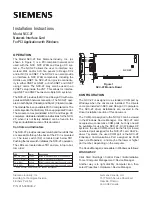
List of Illustrations
v
2
Principles of Operation
Figure 2-1
Block diagram of the KPCI-3101–4 series boards...................................................................................... 2-2
Figure 2-2
Continuous post-trigger mode without triggered scan .............................................................................. 2-11
Figure 2-3
Continuous post-trigger mode with triggered scan ................................................................................... 2-11
Figure 2-4
Continuous pre-trigger mode .................................................................................................................... 2-12
Figure 2-5
Continuous pre-trigger mode with triggered scan..................................................................................... 2-12
Figure 2-6
Continuous about-trigger mode ................................................................................................................ 2-13
Figure 2-7
Continuous about-trigger mode with triggered scan................................................................................ 2-14
Figure 2-8
Counter/Timer channel ............................................................................................................................ 2-19
Figure 2-9
Example of a Low-to-High pulse output type........................................................................................... 2-22
Figure 2-10
Figure 2-11
Example of event counting ....................................................................................................................... 2-24
Figure 2-12
Connecting frequency measurement signals without an external gate input (shown for clock input 0) .. 2-24
Figure 2-13
Connecting frequency measurement signals (shown for clock input 0 and external gate 0) .................... 2-25
Figure 2-14
Example of frequency measurement......................................................................................................... 2-26
Figure 2-15
Connecting rate generation sIgnals (shown for counter 0; a software gate is used) ................................. 2-27
Figure 2-16
Example of rate generation mode with a 75% duty cycle........................................................................ 2-28
Figure 2-17
Example of rate generation mode with a 25% duty cycle......................................................................... 2-28
Figure 2-18
Connecting one-shot signals (shown for counter output 0 and gate 0) ..................................................... 2-29
Figure 2-19
Example of one-shot mode using a 99.99% duty cycle ............................................................................ 2-30
Figure 2-20
Example of one-shot mode using a 50% duty cycle ................................................................................. 2-30
Figure 2-21
Example of repetitive one-shot mode using a 99.99% duty cycle ............................................................ 2-31
Figure 2-22
Example of repetitive one-shot mode using a 50% duty cycle ................................................................. 2-32
Summary of Contents for KPCI-3101 Series
Page 10: ...iv...
Page 15: ...1 Overview...
Page 21: ...2 Principles of Operation...
Page 53: ...3 Installation and Configuration...
Page 78: ...3 26 Installation and Configuration KPCI 3101 KPCI 3104 Series User s Manual...
Page 79: ...4 Testing the Board...
Page 82: ...4 4 Testing the Board KPCI 3101 KPCI 3104 Series User s Manual...
Page 83: ...5 Calibration...
Page 86: ...5 4 Calibration KPCI 3101 KPCI 3104 Series User s Manual...
Page 87: ...6 Troubleshooting...
Page 94: ...6 8 Troubleshooting KPCI 3101 KPCI 3104 Series User s Manual...
Page 95: ...A Specifications...
Page 107: ...B Connector Pin Assignments...
Page 111: ...C Systematic Problem Isolation...
Page 145: ...This page intentionally left blank...
Page 146: ...Keithley Instruments Inc 28775 Aurora Road Cleveland Ohio 44139 Printed in the U S A...












































